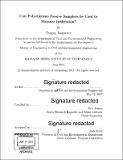Can polyethylene passive samplers be used to measure infiltration?
Author(s)
Raguenez, Tanguy
DownloadFull printable version (6.359Mb)
Other Contributors
Massachusetts Institute of Technology. Department of Civil and Environmental Engineering.
Advisor
Eric Adams.
Terms of use
Metadata
Show full item recordAbstract
Environmental impact assessments on contaminated sites require to understand all of the possible sources of pollution in the field, including groundwater seepage. Polyethylene passive samplers have been used extensively to measure a chemical's concentration in the sediment or water column and conventional seepage meters are deployed to infer the infiltration flux. A model was developed to describe how passive samplers could instead realize both these functions to completely characterize contamination through seepage in the environment. The simulations describe the concentrations in a strip of polyethylene inserted in sediment where porewater flows steadily and vertically. Providing that the target chemical's diffusion and partitioning properties in the sediment are known, the model allows the user to obtain concentration profiles in the passive sampler at different infiltration velocities. Experimental data can then be fitted on these profiles to deduce infiltration within a factor of 2. The approach is promising and was successfully tested in the laboratory using naphthalene, and further studies should be made to fully validate the use of passive samplers as seepage meters.
Description
Thesis: M. Eng., Massachusetts Institute of Technology, Department of Civil and Environmental Engineering, 2017. Cataloged from PDF version of thesis. Includes bibliographical references (pages 58-60).
Date issued
2017Department
Massachusetts Institute of Technology. Department of Civil and Environmental EngineeringPublisher
Massachusetts Institute of Technology
Keywords
Civil and Environmental Engineering.